Dr Swati Virmani
Senior Lecturer & University Teacher Fellow
De Montfort University
Published February 2024
For years, as an educator, I have been passionately following and doing what I enjoy the most. Undertaking approaches that would identify me as a specialist and enable me to work around my strengths. Be it active learning or constructivist or creative methods, I have evolved and adapted my practices to ensure they match with my students’ interests, needs and curiosity. More recently, I have found storytelling as an attractive medium that has proved useful and productive. And more so because my students are exceptional at building, forming and sharing ideas and concepts in the most creative way!
In this case study I will share two mediums that I have been practicing and exploring with my students – one that involves dexterity and one that involves AI.
The three-legged stool – Heart, Head & ‘Hand’
Creative pedagogy is the art of creative teaching. (ref 1) Play as game-based learning, role play, simulations is not new, but what is newer is the adoption and creation of varied forms of playful learning. Lego® Serious Play® (LSP) has its own category. I am a certified facilitator and an AFOL (Adult Fan of Lego!). LSP is a creative pedagogy that emphasises hands-on, experiential learning and encourages participants to use their imagination and creativity to construct physical models that represent ideas and concepts. By reflecting on their own ideas and those of others, students can gain a greater understanding of the topics discussed and develop a more nuanced perspective on complex issues. By exploring concepts in a fun and creative way, students experience positive emotions such as curiosity and willingness. These emotions then promote motivation and a desire to learn that can enhance engagement and overall learning outcomes. Moreover, the method encourages participants to stay focused on the task at hand by creating an engaging learning environment. However, effective implementation of LSP requires Lego® kits as well as the need for facilitator certification, which may add to the financial challenges. LSP approach has had a special focus within business, management and leadership, but it can cross those boundaries.
I have been using LSP with my economics students, be it for the ‘financial markets’ module (Figures 1a, 1b) – discussing the core principles of money and banking – or for the ‘emerging markets’ module (Figure 2) – discussing the cultural, political, economic and legal characteristics of an emerging economy (four groups, each discussing one characteristic; and then bringing the models together to look at the overall economy).
Figure 1a
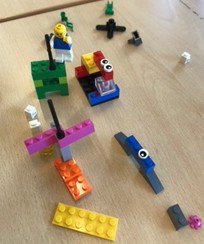
Figure 1b

Figure 2
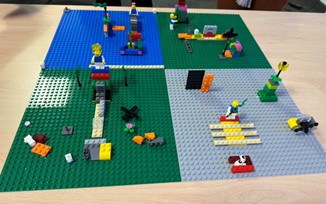
This technique has given my students a sense of ownership and a catalyst for dialogue. There is no generalisation as students can have their own interpretations and choice whilst solving problems. Everyone gets a unique voice that they then bring together to develop shared understanding, form connections and reflect on their learning. It may at times be the case that students need an initial momentum to start the activity, but once the purpose behind the activity is made clear and how LSP is tied to their learning, students evolve naturally.
Observing the enthusiasm and adeptness my students have displayed using LSP, I've incorporated ‘originality & creative thinking’ as an assessment criterion for a module I teach and lead on the Master's programme (Figures 3a, 3b). There is a presentation-based assessment, a group task, where students have to role play as managers of a UK based company aiming to invest and expand its business in an emerging market economy. Students have to design a market penetration grid and rank various indicators to determine the outcome of where to invest. After completing the ‘usual’ presentation each group gets 5 minutes to think and construct a Lego® model to depict their investment strategies. At the end, it is all about their interpretation, articulating ideas and understanding, communication and reflection: no right or wrong answer!
Figure 3a

Figure 3b
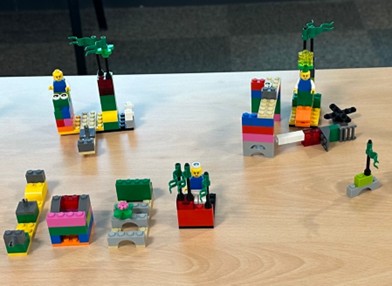
The incorporation of Lego Serious Play into my teaching methodology has had a remarkable impact on student engagement and attendance. Students eagerly anticipate sessions, demonstrating a newfound enthusiasm for learning!
Digital storyboarding – sketching scene by scene
AI is adding colour and imagination to our classrooms, giving us the option to ‘construct’ and discuss in real time. (ref 2) One such use case is storyboarding: a visual representation of a story, narrative or concept. Storyboard teaching in Higher Education is not a new approach. (ref 3) It was crafted as a technique to engage both the creative right brain and the analytical left brain of learners. Employing storyboarding as a technique improves the retention of key ideas and visual elements around a concept by emphasising important events. It enables learners to communicate ideas from one’s creative brain to wider audience, and also offers a unique way to learn concepts visually.
Whilst discussing the uses of varied AI tools with my students, and looking at the creative potential of AI image generation starting with concept-based images: prisoners’ dilemma, Figure 4; liquidity, Figure 5; credit crunch, Figure 6. I discovered my students’ interest and enthusiasm to pursue this further, and the idea to elevate this form of constructivist approach with AI.
Figure 4 (tool used: OpenAI’s GPT-4)

Figure 5 (tool used: OpenAI’s GPT-4)

Figure 6 (tool used: OpenAI’s GPT-4)

I am sure those of us who have been using AI would know that many times the tool asks for a description rather than a single word prompt to sketch an image that would match our expectations. This drove me to experiment with the concept of composing a complete storyboard, directing an AI tool to define a term, write the scenes/sequences, and subsequently transform each scene into a descriptive image. We tried something as basic as diminishing marginal utility. Figure 7 shows the entire storyboard consisting of three scenes: (ref 4)
- The first scene shows a child happily eating an ice cream cone, representing high initial utility.
- In the second scene, the same child is eating a second ice cream but looks less satisfied, indicating decreased utility.
- The third scene depicts the person with a third ice cream, looking unhappy, symbolising very low or negative utility.
Figure 7 (tool used: OpenAI’s GPT-4)
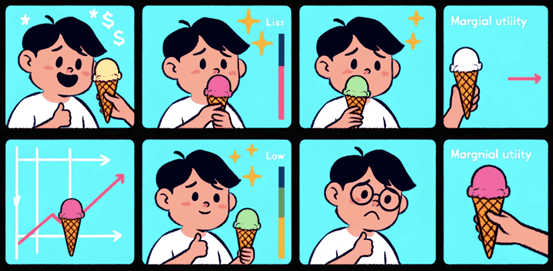
Advancing to a more intricate task, we attempted to generate a storyboard around the Global Financial Crisis. If you ask the AI tool (GPT-4, Copilot) to create an entire storyboard for a concept on its own, the resulting images are often disjointed and disillusioning, hindering the creation of a coherent narrative. These images might feature inaccuracies in the text, or even worse, the response could be limited to a single image. Considering this, we opted to begin by addressing the concept, plot, characters, and time period. Here is an example:
concept = global financial crisis
plot = rising demand for houses/ property market, huge and risky bank lending, housing bubble bust, fall in price of houses, banks net worth declining, mortgage repayment failures
characters = commercial banks, households, central banks
time period = 2007-2009
This gave us a scene-by-scene narration; it was then up to us to make changes, suggest additional information, and ensure the storyline coincides with our understanding of key concepts. Once happy with the structure, we selected each scene to serve as a prompt for generating images. So basically, the AI tool's response becomes the next prompt. And we got a set of images to work with, shown in Figure 8a.
Figure 8a (tool used: OpenAI’s GPT-4)
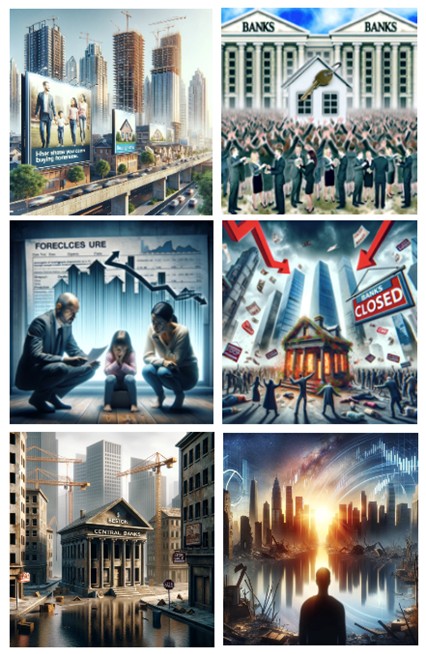
Act 1: The Rise of Dreams - The bustling city skyline with new buildings, symbolizing the booming property market.
Act 2: The Bubble Swells - The crowded housing market scene, representing the peak of the housing bubble.
Act 3: The Cracks Appear - The worried family facing foreclosure, indicating the beginning of the market's downturn.
Act 4: The Burst - The chaotic scene of the housing market crash, capturing the panic and despair.
Act 5: The Fallout - The deserted financial district, portraying the aftermath of the crisis and the slow recovery process.
Last: Conclusion - The reflective scene, showing hope and recovery, and highlighting the lessons learned from the crisis.
With very few exceptions, students do not have access to the paid version of AI tools (such as Open AI’s GPT-4 in this case), and I personally do not advocate subscribing to them either. The issue of the digital divide is a significant topic that warrants a dedicated case study. (ref 5) Further, I also do not completely approve the use of free image generation tools, as even seemingly free tools come at a cost in terms of data. So how do I ensure each student is participating? One solution has been Copilot (for educational users), as shown by the images in Figure 8b. But there are some issues here. Copilot does not save chat history, which is a good data protection measure. However, if there is a loss of connection or poor network connectivity, and you need to reconnect, the absence of chat history means starting over again, similarly if you wish to return to the chat and pick up where you left off in the previous session. Another persistent challenge we have encountered with Copilot involves instances of inaccurately spelled text or untidy scribbling appearing within the images it generates. Upon requesting their removal, one might receive the response that the text is integral to the graphic. Up to this point, therefore, OpenAI's GPT-4 has proven to offer a smoother user experience.
So, frequently, my students engage through their narrative abilities and adeptness at storytelling. They contribute by crafting plots, describing characters, rewriting or enhancing scenes, and weaving the storyline together. In this collaborative effort, my students actively participate in writing the prompt, while I simply input the prompts to generate images. This collaborative process, which can be facilitated seamlessly with students generating scenes and description using GPT-3.5, has proven to be effective. Moreover, we have found that descriptions generated using GPT-3.5 often tend to be more comprehensive compared to those produced with Copilot. We are currently in an exploratory phase, experimenting with various methods to convey narratives about the concepts, present materials, and collaborate. Given the wide range of choices and possibilities, as well as the varied outputs produced from identical prompts, our exploration is ongoing! For future sessions, I am also considering using pre-constructed images and challenging students to identify concepts or construct stories based on them.
It is noteworthy to observe how effective students get with prompting. But we must remember that AI is not the end goal here, neither is LSP, the focus is on giving varied constructive mediums to enable students to communicate and learn creatively. As an educator I ensure how well, and whether, storytelling will enrich the aims of my session, what purpose does it serve, and what are the learning outcomes. It is about effective communication (ref 6) and reflective learning, thus echoing the skills and attributes that employers increasingly value.
Figure 8b (tool used: Copilot)
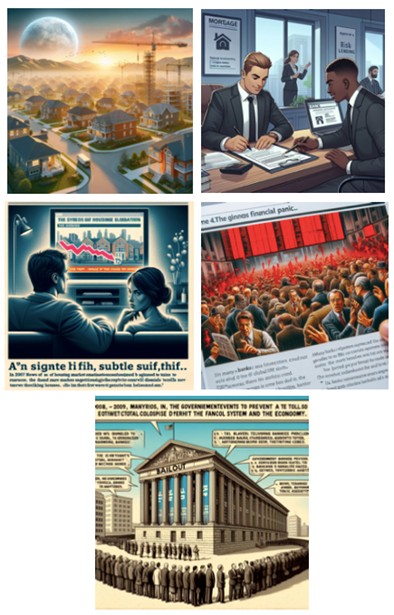
Notes
1. Aleinikov, A. G. (2013). "Creative Pedagogy." In: Carayannis, E.G. (eds) Encyclopedia of Creativity, Invention, Innovation and Entrepreneurship. Springer, New York, NY. https://doi.org/10.1007/978-1-4614-3858-8_13
2. This case study doesn't focus on specific AI tools or on how to become an AI expert; rather, it centres on the practical application of AI in a particular scenario.
3. Lottier, L. F. (1986). ‘Storyboarding your way to successful training’, Public Personal Management, 15 (4), 421–427. https://doi.org/10.1177/009102608601500410
4. This is not the initial iteration; AI tends to generate misleading images, frequently resulting in entirely unproductive outcomes. The process is highly exploratory.
5. McKean, P. (12 September 2023) "Without intervention, AI could widen the digital divide for students" Jisc https://www.jisc.ac.uk/blog/without-intervention-ai-could-widen-the-digital-divide-for-students
6. Colvin, C. (2022). “More Talk, Less Chalk: Communicating Economics in the Modern Classroom”, Economics Network Case Study. https://doi.org/10.53593/n3526a
↑ Top
